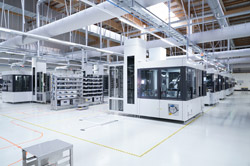
Posted to News on 30th Oct 2019, 12:41
Sick's smart factory for sensor production
Sick has built a truly Industry 4.0 factory for the production of its latest sensors. This article explains what was involved and the benefits being delivered by the new smart factory.

Step into Sick's futuristic new Industry 4.0 production facility and the first thing you notice is the quiet. Then, you see the pristine rows of glass-encased robotic production cells and the fleet of small, elegant automated guided carts (AGCs) gliding effortlessly between them.
Nestled in the valley town of Hochdorf, near Freiburg in the German Black Forest, a fully-operational Smart Factory has been built from scratch. Sick's smart photoelectric sensors, among them core product ranges including the NextGen sensor family, are manufactured in high volumes and with a high level of product variety.
Conventional, linear mass production has been left far behind. Instead, a modular production process has at its core 12 automated technology cells. Instead of a conventional linear manufacturing sequence, the workflow progresses flexibly with each customer order, so material flow can be optimised and the best use made of available production capacity.
Two-year development
Sick has been investing in developing the facility for more than two years and is now ready to open its doors to industry, keen to share what it has learnt to date.
Bernhard Mller, Senior Vice President for Industry 4.0 at Sick AG, comments: "At Sick, we see Industry 4.0 as fundamental to our future development as a manufacturer of intelligent sensors and sensing systems. Most people understand the concept of Industry 4.0 by now, but relatively few have had the chance to turn a theoretical idea into practical experience. It has been a rare privilege, and we have often felt like explorers and pioneers."
Think of Industry 4.0 and most people might understand the concept of digitised connectivity between machines that makes production processes more transparent and manageable globally. Certainly, autonomous digital production and control were an essential foundation in the blueprint for the Hochdorf facility.
Yet what sets the factory apart as a flagbearer for Industry 4.0, above all, is its fully-flexible operation, down to the almost-mythical 'lot size of one'. While its annual capacity may be upward of 1.2million items, there are virtually no limits to the variety that is conceivable. Small production batches can be easily accommodated at an affordable price for customers. Sick can react flexibly to customer priorities, even at short notice, using a highly-responsive production control system.
How has this been achieved?

As a working production facility, the factory has been planned to meet commercial and pragmatic realities, rather than indulging higher Industry 4.0 ideals for their own sake, stresses Mller.
"Using both automated and manual processes leads to the most efficient and economical level of automation for us. Our material flows are handled both by automated carts and people, and we still use some manual as well as automated assembly processes."
To start a production order, the product variant requested by the customer is configured online in the production control system. All the data to configure the sensor is taken from the Enterprise Resource Planning (ERP) system: the product specification and quantities, as well as the steps required for its manufacture.
Building to a recipe
Sick has called this the customer's 'recipe' used to progress each Manufacturing Order (MO) through the facility and make best use of the workspace. Material transport is handled by the AGCs that receive their orders via the network and support flexible production by optimally linking the production steps. Rather like calling a taxi, the nearest AGC reacts.
All workflows are managed by the high-performance production control software developed in-house by Sick. The system sends information to the machines and receives constant feedback in return. All of the contributing elements, sensors, machines and people are organised remotely, networked, and are in constant communication with each other.
As a result, the system is super-responsive in order to juggle customer priorities and closely track order progress. Orders are prioritised and the production modules and staff are deployed most effectively. Just-in-time production is enabled. The production manager can concentrate on optimising efficiency rather than having to spend time scheduling which machines to use.
Real-time view

Naturally, Sick sensors of all kinds - smart sensors, laser scanners and vision cameras - are at the heart of every process. Each production cell/module uses Sick sensors for its own automated quality control using an integrated camera Automated Optical Inspection (AOI) system to check the work step and reject any sub-standard assemblies. Once the entire process in the cell is complete, confirmation is passed to the control system and an AGC is called, so the part can continue its journey to the next station.
Indeed, sensors are the foundation of any Industry 4.0 scenario, as the essential data suppliers for control systems, stresses Mller. Not only do they provide vital process data, but also valuable feedback about the health of the sensors and machines themselves.
"We only install our own sensors and sensor systems in our plants. They have to be able to demonstrate what they are capable of here under real conditions. As you might expect, we have implemented effective predictive maintenance, as well as having real-time responsiveness to any issues, achieving exceptionally high manufacturing availability."
Continuous improvement
Importantly, there is an atmosphere of learning and knowledge feedback at the Hochdorf factory, with opportunities to share experiences and ideas clearly evident in collaborative workspace areas.
Mller says: "With every day that goes by, we are collecting valuable knowledge when it comes to developing and improving this type of production, as well as the ongoing optimisation of our own products, solutions, and services.
"We are gaining important insights into how our sensors work and finding where we can still make improvements. We are gaining inspiration to implement new product developments and bring them to market much faster."
For many, Industry 4.0 will not be a start-from-scratch undertaking. However, the experiences at Hochdorf demonstrate how companies of any size can take on board aspects of a factory of the future today. Industry 4.0 technologies from Sick help to accelerate production, streamline material flow, optimise capacity utilisation and respond more flexibly to customer priorities. They enable proactive maintenance and intelligent data exchange on demand.
New paradigms
Mller states: "Today, Sick customers are able to combine our sensors at the field level to achieve Smart Tasks and decentralised applications. These will be the more common retrofit projects that will begin to challenge us every day to think according to new paradigms.
"This experience taught us that, with Industry 4.0, you can never draw a line and say, 'It is all over; now we are finished.' We are always turning a corner to discover the next new idea; we are forever reimagining our processes and applications as we gain new insights."
In the past, establishing a new volume production facility might well have been all about fixed equipment to build one product, or a small number of variations. Now, Sick has embedded a universal flexibility into its Smart Factory to adapt and develop in future, adds Mller.
"Our plants are capable of manufacturing products that we have not even thought of yet."
For more information about Sick's Industry 4.0 products and services, go to www.sick.co.uk.
Want the latest machine building news straight to your inbox? Become a MachineBuilding member for free today >>















